
Okay, I will be first to admit it: I occasionally dash off very bad charts to fling at my trusted musical partners the night of the gig when I am in a big hurry. I am a jazz & church pianist, vocal accompanist, and sometimes sing a few numbers on my gigs too – yet, even when I know better, now and then I fall short and exhibit CSS symptoms. Although this article resembles ‘preaching to the choir’ (including myself in that group) – it is a more detailed exploration into writing music extracted from my blog, Do You Suffer Chick Singer Syndrome?)
I’d like to share a few examples ranging from pitiful to pretty good charts (both lyric and lead sheets), that I have either personally penned or have been instructed to “Just read the chart and listen to the YouTube link and figure it out.”
The following levels apply to charts written by today’s jazz and church musicians, vocalists, accompanists and band members. Remember, men and women can suffer Chick Singer Syndrome – even superbly talented ones! So with a touch of humor, kindly read on.
Contents
HOW TO (or NOT TO) WRITE CHARTS LIKE A CHICK SINGER
The worst kind of chart is no chart at all. A person with CSS insists they can sing in any key, or ‘usually in B’, or some such nonsense, or they might hum their first few notes and hope you can figure the rest out from there. We will rate no chart as a ZERO (0) on a sliding scale of Chick Singer Syndrome Charts to Professional Arranger Charts.
Next up the scale:
LEVEL 1
Chart has just the lyrics printed, names the key (maybe), with random chord changes scattered here and there (no telling how long the measures last, or where the downbeats are). Lyric sheets like these may be obtained from the internet, often with questionable chord changes and weak sounding bass notes, probably transcribed for the ukulele, or by a hobbyist guitarist with limited music knowledge.
Sheepishly, I’ll admit that the following chart for Do Right was scribbled out by me – the musicians I work with luckily managed to get the hang of it in spite of my CSS:
The next several examples that use my repetitive and deliberately confusing tune Praise Hymn, are taken from my book The Complete Church Pianist: A Piano/Keyboard Method with Tips for Inspired Improvisation and Worship. The following lyric sheet for Praise Hymn represents a typical example of what the musicians in today’s church bands are given to read:
LEVEL 2
Like the level above, but with a few penciled in directions, such as “VERSE” “REPEAT” “CHORUS” and “BRIDGE”.
LEVEL 3
Bar lines are drawn on the lyric sheet, and all chords are included above the words, even during ends of phrases where there are no lyrics below. Tempo markings such as “UP TEMPO” “MEDIUM” (or specifically =120) along with grooves such as “SWING” “LATIN” “FREELY” or “WALTZ” are written in. There may be specific chords indicated for an “INTRO” and “ENDING” with instructions like “TRIPLE THREAT”, “3X”, or “Watch for CUE” & “CODA last X” just to make things clearer. This type of chart could possibly be good enough to hand to experienced musicians who are used to backing singers (provided the singer knows what they are doing, how to count off a tune, cue the ending vocally, and also with body language).
 LEVEL 4
LEVEL 4
The vocalist hands each band member a copy of the same chart including the melody written out (plus all the above level 3 directions). Pianists like myself who accompany many singers love to see the melody.
Accompanists can then appropriately voice chords to enhance the vocal line, perhaps play off the melody during a solo, understand where the singer is during the music by seeing the lyrics/chords/melody, and just in case the singer gets off track they can reel them back in. Additionally, when jazz musicians can see the melody with chords it gives them an idea for appropriate substitute chords that won’t clash with the vocal line.
 Compare the previous chart of my tune, Don’t Mess With Your Sugar Mama with the following version, written out by vocal arranger Robert Kim Collins. Notice more direction and attention to details?
Compare the previous chart of my tune, Don’t Mess With Your Sugar Mama with the following version, written out by vocal arranger Robert Kim Collins. Notice more direction and attention to details?
LEVEL 4.5
LEVEL 5
A specific chart is written for each band member, with color coded cues, rhythm marks for the drummer, instrumental fills, lines, and punches are fully written out. Intros, first and second endings, correct measure line types, and final endings are all legibly and neatly printed into approximate 4 bar phrases on each line, with new sections starting on the left side of the chart so musicians can suddenly hop to the BRIDGE or find a D.S. or CODA. This totally Type A Chart should ideally fit onto 2 pages max (in case it needs to be clipped down for an outdoor gig, thus avoiding page turns in the wind).
The following examples show my arrangement of And They’ll Know We Are Christians By Our Love, written for a recording session involving 2 horns plus rhythm section. Observe the 4 charts for 5 musicians (bass & drums may both read off of the bass/rhythm chart). I’d rate these a LEVEL 4.9 on the scale:
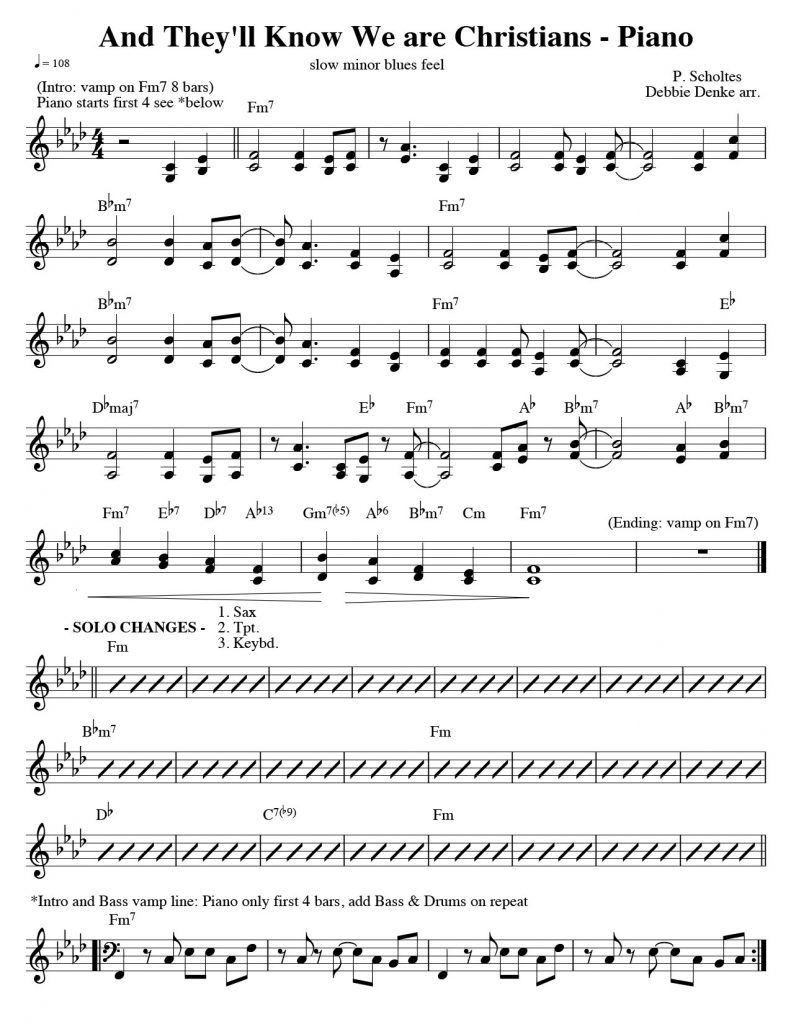
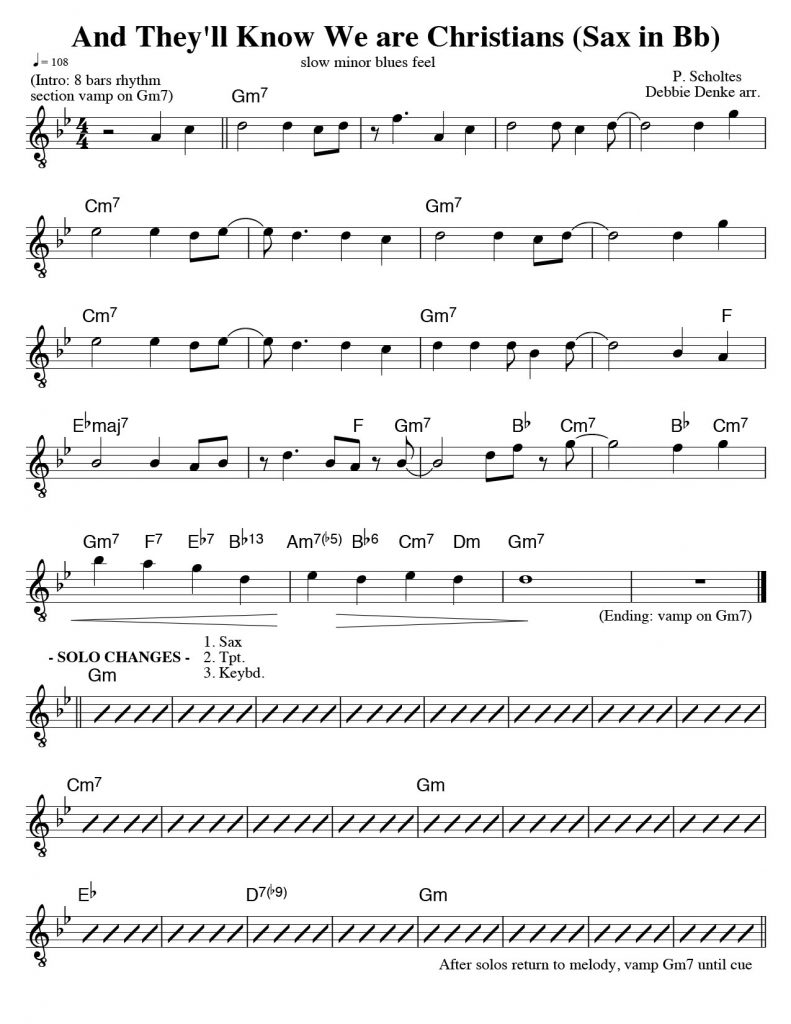


You can hear an impromptu live performance with a slightly different form of And They’ll Know We Are Christians By Our Love (piano, bass, 2 guitars). Look under the video section of debbiedenkemusic.com.
You may be asking yourself, “Does anybody actually go to the trouble to write out a different chart for each band member?” Truth be told, I was involved in a George Shearing Style Jazz Quintet for a few years, after the founder/transcriber/arranger/pianist James Argiro temporarily handed me the baton and his books when he left for the East Coast. Jim had perfectly notated by hand all of his arrangements – directions, notes, chords, rhythms, accents – every tune had 5 unique charts. Imagine a perfectly written part for each instrument: Piano, Bass, Drums, Guitar, and Vibes.
Jim Argiro’s arrangements were special and the band was a great experience to be a part of – Lots of detailed notes to read, while we imitated a blind pianist and his intuitive quintet’s sound! Great examples of LEVEL 5 charts, written with the precision of a true orchestrator.
This article was written to help both singers & musicians recognize CSS symptoms so they don’t fall into the stereotypical behavior mentioned here and also in my article, Do You Suffer Chick Singer Syndrome?
A big shout out goes to all the very talented, hard working, & delightful singers/musicians I have the pleasure to accompany, partner with, or direct. Apologies go out to my musical partners when I slip up now and then and hand out sub-par charts. 😉 -D.D.

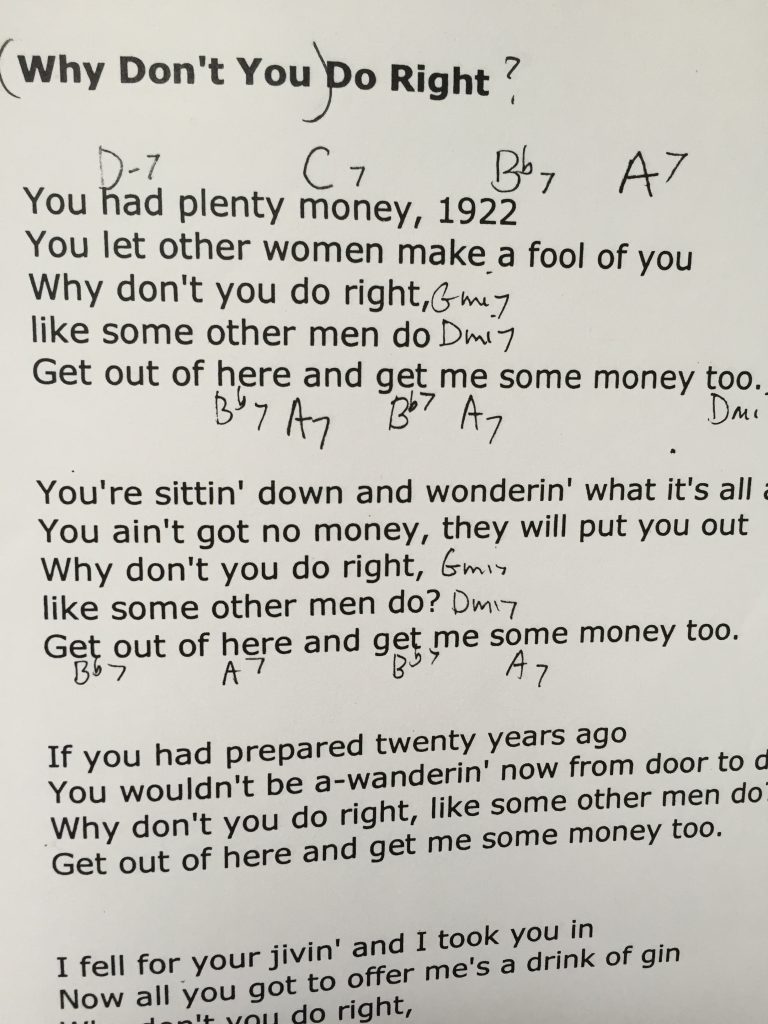
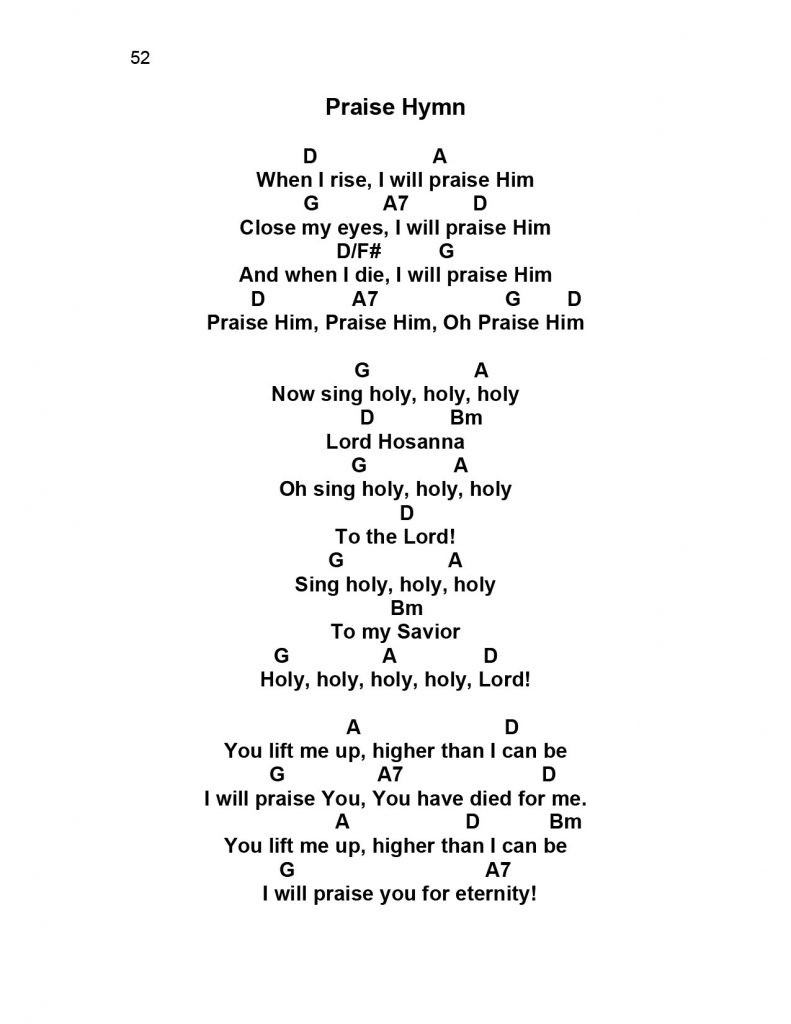
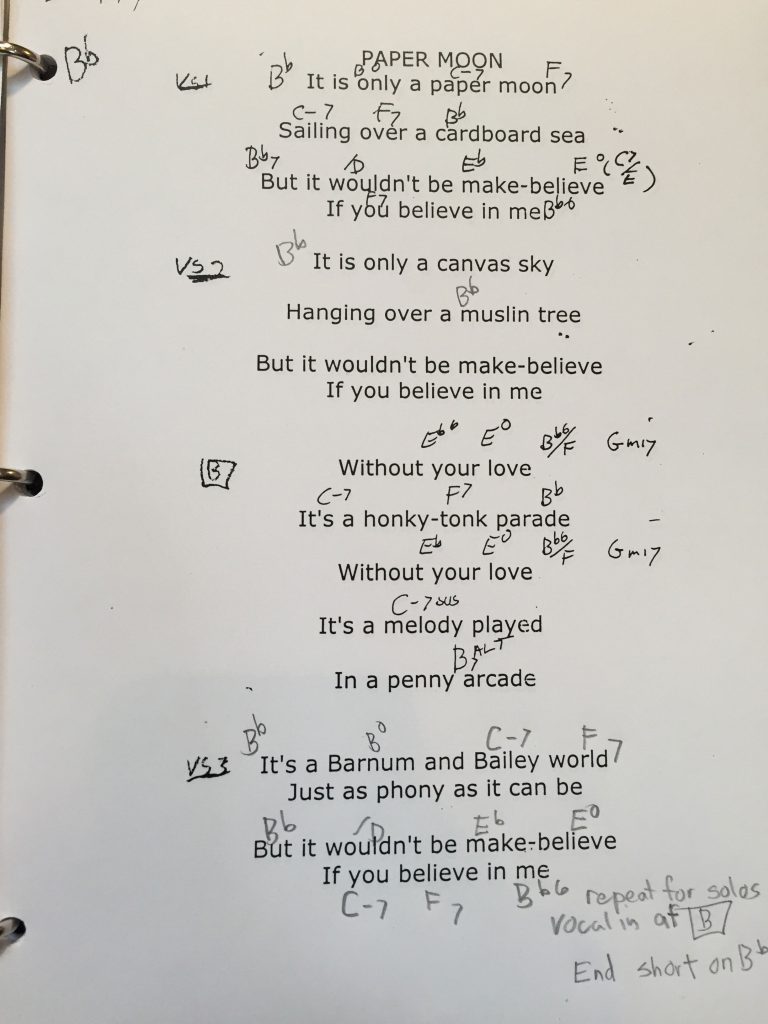
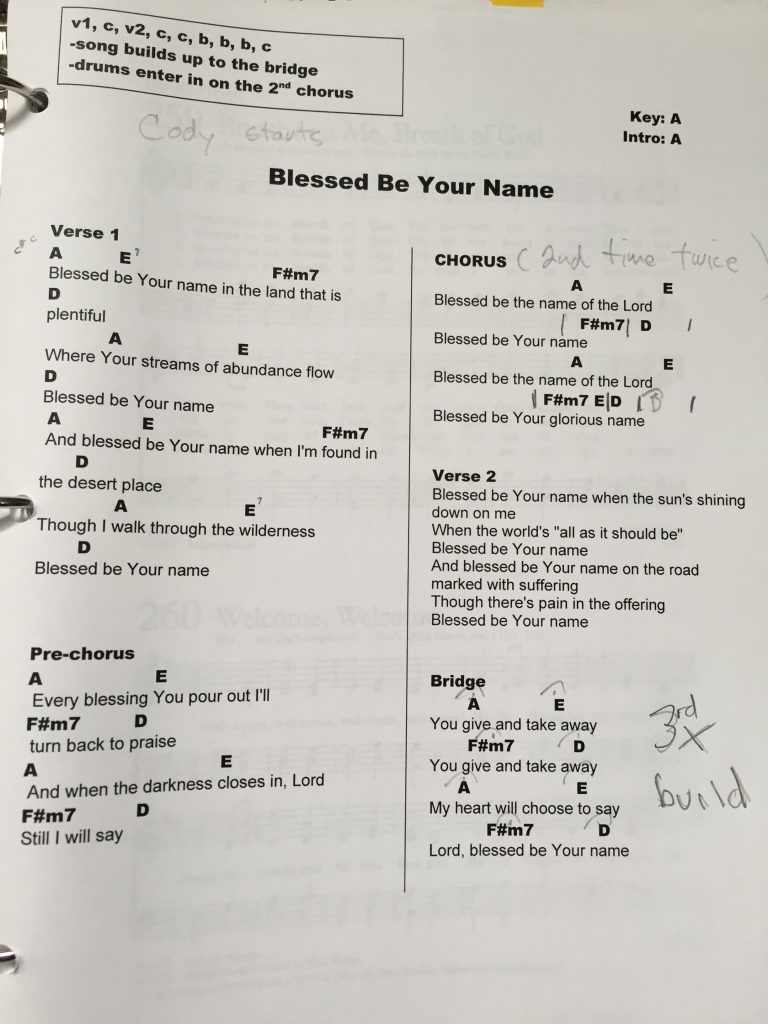
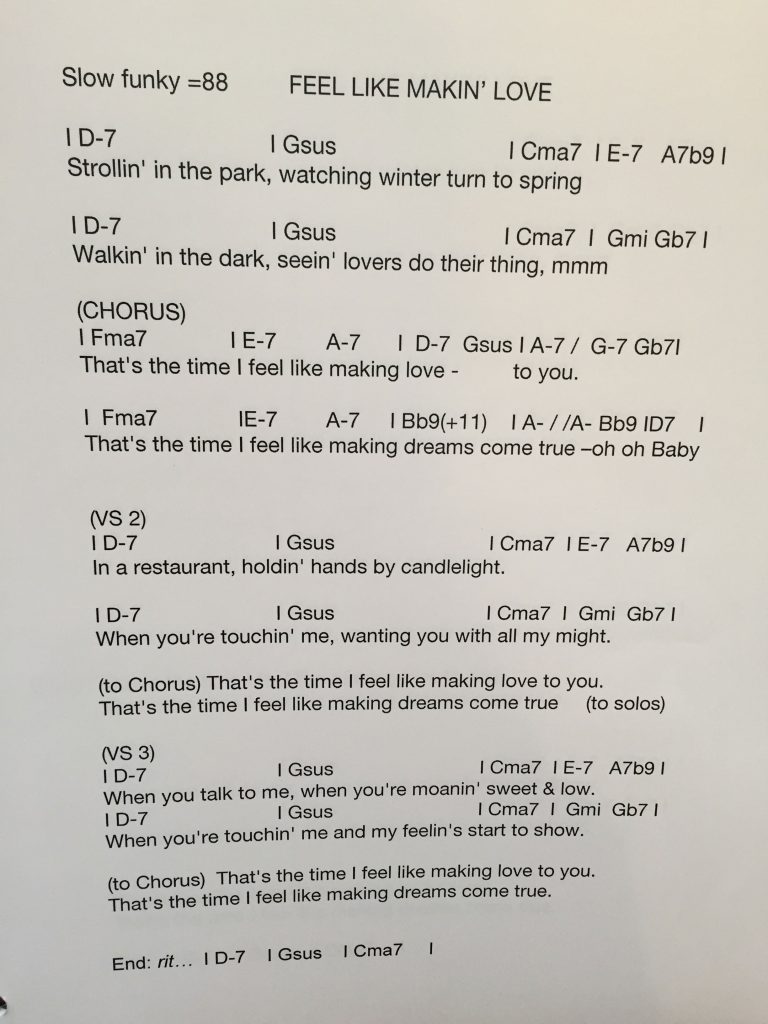

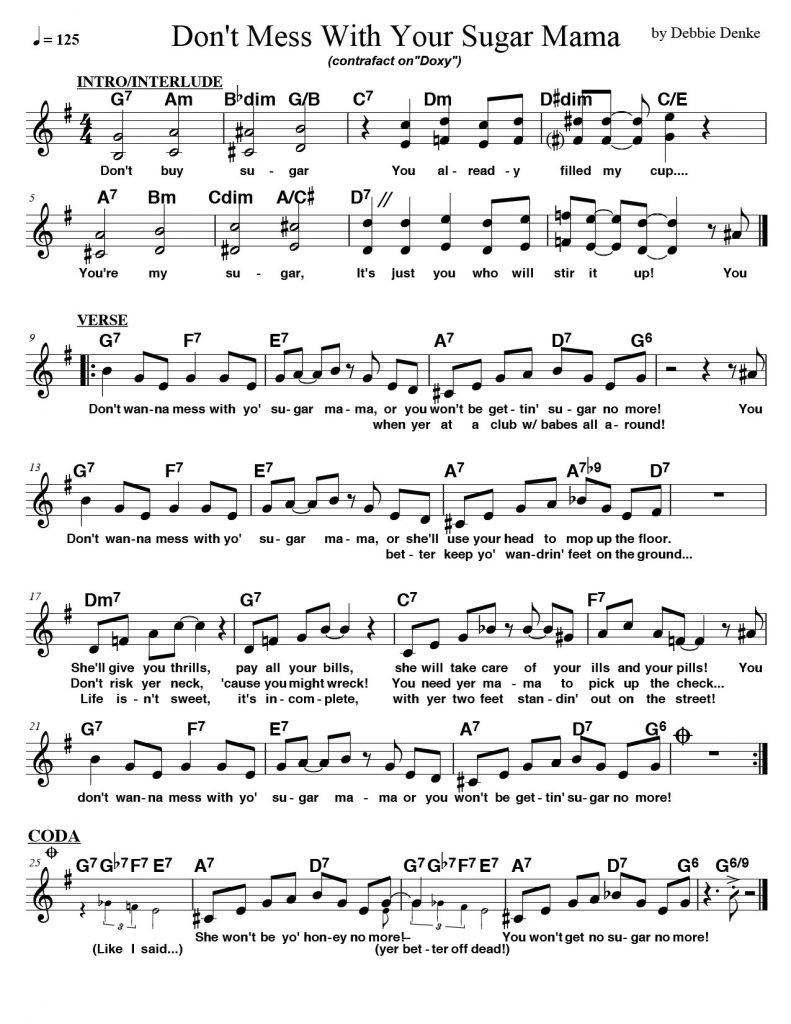
How nice to be mentioned here! Thank you very much Debbie. I still miss those days at the Biltmore. I hope all is well with you and family.
I still have the quintet with some great players. Check us out at: argiroquintet.com
We were featured in the movie Chasing Rainbows.
Jim has great charts
Enjoyed working with him
How are you?
I never thought that i could sing! Try this: ==> https://tinyurl.com/y9gy8smj
This is the greatest article on singers supplying charts for casuals that I have ever seen! You show deep knowledge of the Force with comments like “… questionable bass notes, probably transcribed for ukulele”. I spit out my tea! This is exactly where a lot of those old-fashioned fake books got their chords!
I was directed here from the Gigs From Hell Facebook page. This article is deserving of wider recognition in light of its prevention of possible Gigs From Hell. I bet you get musicians recommending you for gigs purely on the basis of your lead sheets.
Sounds like my tone resounds with you Christopher, and here’s to better charts in the future! -Best, DD
This is great! I will share with people who need to see it. Many times it comes down to lack of training or musicianship, but there’s really not a good excuse for that. My favorite is when someone makes charts for everyone except the drummer (me!), typically followed by the comment, “I didn’t figure you’d need a chart”, as though all drummers are ignorant idiots. LOL!
Glad my article rings true for you, Mark. I knew the Sunday morning church band I am working with was starting to catch on a bit because the drummer is now ASKING to be given a chart! (I had to nicely ask one singer to please step forward 2 inches so the drummer and I could see each other for my cues… She actually said, “Why? I don’t see why that is important!” She rebelled at standing closer to the mic. We turned the base of the mic stand & swung the arm further out so she could move up – Each Sunday must repeat! Best, DD